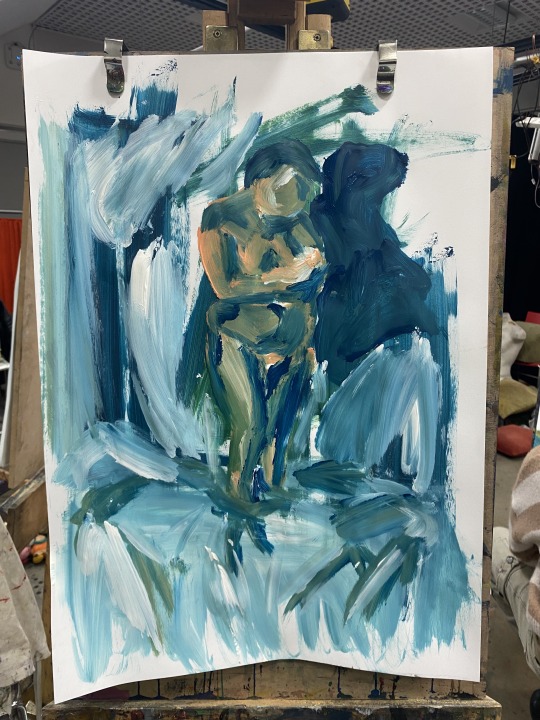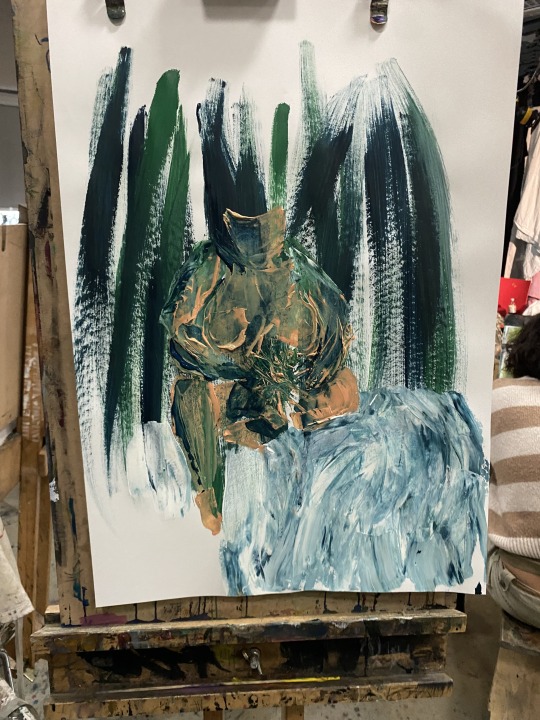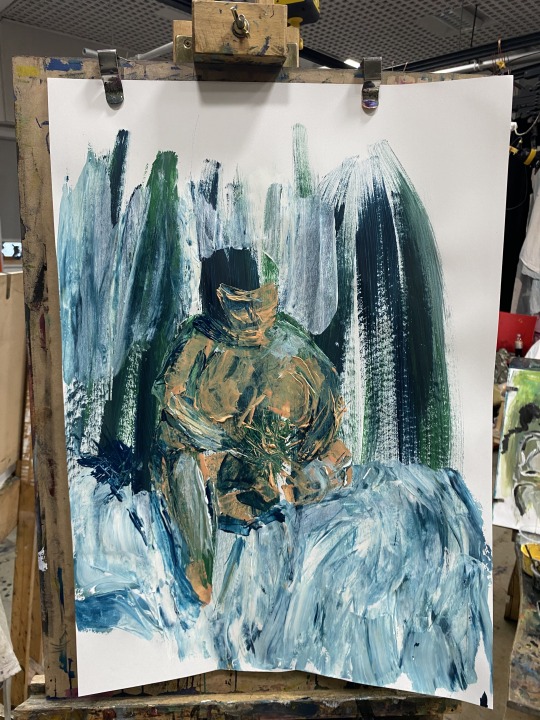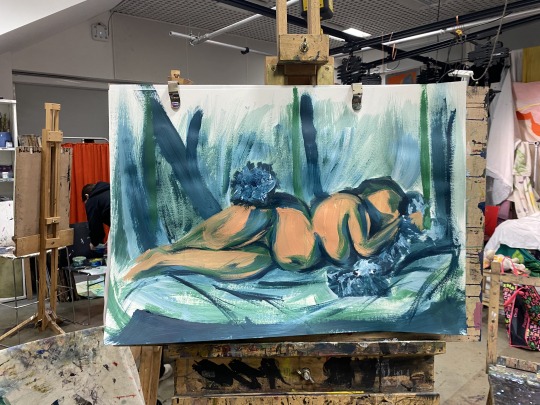Don't wanna be here? Send us removal request.
Text










I really enjoyed this session. My confidence in applying paint to the page has gone up and my flexibility to change things that are no longer working is growing. I'm enjoying using different application styles as well as different brushes and sponges whilst I'm painting and I'm finding it easier to change things up whilst in the process of painting.
#illustration#mdxillustration#life drawing#illustrator#artists on tumblr#drawing#animation#acrylic painting
1 note
·
View note
Text













This was a self directed session which was really fun as we put all of the techniques we had been exploring to the test. We started off with some really rapid paintings with the model changing position every couple of minutes or so.
I was dividing my time into the three sections of form, accents and area but found it hard to get into the area with the amount of time we had, however, I really like how those paintings came out as I worked on the same sheet of paper where I could. I liked how the white paper acted as highlights in areas due to the dry brush painting technique I applied. I'd like to paint like this more often.
As we began to paint longer poses, I was able capture more of the scene each time. I'm getting more confident with how to use the colours and how to create a flattering scene for these forms to be a a part of... I'm getting there.
0 notes
Text




12/03/2024 cont.
Here we experienced painting multiple models at once which was a good way to challenge our ability to capture a lot from the scene in a short amount of time.
I tried this time to think of the background and space around the form and how that would work and embellish the paintings. I also tried to think about the composition of the page but I need to get more creative with this.
#illustration#mdxillustration#life drawing#illustrator#artists on tumblr#drawing#animation#acrylic painting
2 notes
·
View notes
Text











13/03/24
In this session, we continued to separate our paintings into three sections. The first section of time would be for us to focus on form, the second on accents (areas of light, shadow, details etc.) and the third would be for area. However, this can be done in any order which is what I tried to experiment with.
I feel it took me a while to figure out how best to use the colour palette I had selected. I should have tried to use orange and pink for the form and area whilst using blue for highlights. I'm still getting used to working with the area as I feel I don't know when to stop sometimes. Less is more in some cases so I need to spend some time focussing on understanding what I am seeing and capturing that.
#illustration#life drawing#mdxillustration#illustrator#drawing#artists on tumblr#animation#painting#acrylic painting
3 notes
·
View notes
Text





5/3/24
Today we continued with dividing time between form, accents and space. Instead of working on form first, I worked on capturing the space and environment as that's something I tend to struggle with. This is most likely down to the fact I leave it till last.
Aldous says that how we see in daily life is on a need to know basis. What he encourages us to do is is to take time and notice what we see for no other reason than that we are just drawn to it. These areas are important because they have captured our attention.
Once in the flow of noticing what I'm drawn to, it was easier to work quickly, instead of focussing on one point and spending too much time on a small detail.
Questions to always keep in mind:
what is the shape?
what is it doing?
what is the space?
what is it connected to?
The last image includes a painting by another student that I really liked. I've been using a variation of brushes and applications today which is easy to see has also been the case with this piece.
Do not look for angles without considering what they are connected to. Keep conscious of what is happening and if you don't know, ask yourself.
"The information is there, you just have to ask for it"
1 note
·
View note
Text









13/02/24
In todays session, we took a few steps back in how we went about painting. We created a series of 3 minute paintings, spending the first 60 seconds on creating the form, the second on accents and the third on background. It was interesting to see how much I could get on the page in a small amount of time and to still end up with something substantial. The main focus was to look at the space, look at the form and look for where they connect.
Three things to remember are:
everything is a shape
everything is doing something
everything is abstract
It was hard to get the hang of creating a background that complemented the focus and that worked with it effectively. This is something that I need to work on.
#illustration#mdxillustration#life drawing#illustrator#artists on tumblr#drawing#animation#painting#acrylic painting#female artists#acrylic
1 note
·
View note
Text




6/2/24
Today, we started off again by selecting a piece of art to use as a reference for a colour palette of 3 colours. I chose a piece of Indian art and selected two shades of green, one more teal and the other lime and a hot pink. Today, I’ve tried to stay as conscious as I can when painting. Recognising when and what I’m looking at and having the painting reflect that. I’ve also used a variety of tools to paint with and have made more effort to use different strokes whilst painting. I’ve used a pallet knife, sponges, brushes and sticks to paint with today. This has allowed me to create something that has layers to it. Literally. Each tool has allowed me to paint in a different way, whether intentionally or not.
Aldous spoke of the scene before us as a ‘phenomenon’ which is just what is. It’s how we experience the phenomenon that is interesting. To remain present and aware of what we are seeing as we are painting and to let that effect how we paint. I feel like I liked the paintings I did last week a lot more than those I’ve done this week; however, Aldous reminds us often that if we don’t like what we’re doing, it’s often because it is affecting us, it’s doing something. So instead of dismissing the painting and the feeling, take it in and work with it.
0 notes
Text







30/01
In today’s session, we worked with paint and colour again. When selecting a colour palette to work with, we took an art book at random from the library and chose a painting that we liked. We then took three colours from that painting and recreated these colours on a paint palette and then in larger quantities in pots. I chose Claude Monet’s Waterloo Bridge, Sun in Fog, 1903 which had a beautiful blue, green and orange colour palette.
We were reminded that when we are looking at the composition, we should always think about the feeling of what’s within the composition. When we look at different materials and surfaces, we are subconsciously assessing how they feel from experience. Also, another thing to keep in mind is the difference between drawing and painting. When painting, we are focussing more on area. Aldous encouraged us to fill the page with colour, not focussing too heavily on the subject but on everything around the subject because that’s just as important when capturing a scene.
I did 5 pieces today. The first two were done in 9 minutes and were picked up for another 9 minutes after we had looked at one another's work. Aldous encouraged us to use a range of applications whilst working with the paint, so I began to paint with sticks, sponges and pallet knives. I really enjoyed using he sponge because it blended the paint so effortlessly and smoothly. The pallet knives and sticks were fun to use as they take away the control you have and make up many little details in just one stroke. Throughout the day, it soon felt natural to go between utensils rather than getting stuck on one way of working. I felt the range of strokes brought a lot of energy and depth to the paintings and made each one very different from the last.
0 notes
Text





23/01
Today we worked with paint and most importantly, colour for the first time properly. We started by just jumping in headfirst and doing a 10-minute painting. Once we had finished, we put all of our pieces up on the wall and had the opportunity to not only look at others work but to see our own piece from a new perspective. Although I know it’s important to pause and step back throughout life drawing, it felt like I had no time to do this at this point because I was too focussed on ‘finishing’ the painting. However, it’s more time efficient to take pauses and step back because you’re able to see the piece for what it is and therefore what’s working and what isn’t.
Aldous suggested that we work with complementary colours, so I chose orange and blue. Two colours that I’m not that fond of together but I thought it’d be interesting to work with to see what I could do with them. We were to paint with the intention of these two colours representing the tones of the scene. At first it was a little hard to compute from the scene I was seeing into the piece I was creating, however by the second piece, this became easier. In my second piece, I worked with a painted coloured background and used long and elegant strokes. What Aldous suggested everyone do was to incorporate a selection of different approaches to painting in the same piece. What we must think about is the nature of the material we are using; how we can use it and what it is capable of and the nature of the picture; what are we capturing and how we can portray it. I think something I struggle with is knowing and trusting myself when I feel a piece is done. I’ll keep adding to it until the time is up rather than spending more time away from it and looking at it from a new perspective. I really liked how my second painting came out as I’ve not really painted that freely before. Usually, I’d have drawn something already and then I'm just filling in the spaces. It reminded me of painting as a child and how free and rewarding that was because I wasn’t thinking so much about the result or what someone would think of it, I was instead, just enjoying experimenting and having fun.
For my third piece, I wanted to work with one colour more predominantly than the other and chose blue to be my main colour. I was also rougher and more generous with my paint application this time and used a mixture of wet and dry strokes. I liked the tone achieved with the small amount of orange paint overlaying the thick blues. I used water to mute these colours down and to blend them together. It was interesting to see how even the smallest application of orange would appear to create so much detail in the piece.
For my fourth piece, I wanted to really push myself and paint in a completely different way. I used a bigger brush and started with long, hard and uninterrupted strokes of blue and then added smaller and quicker strokes of orange in highlighted areas. The dry brush painting creates a lot of texture and shape itself and its enjoyable to work with a result that I didn’t necessarily envision when I started. I feel like this piece was another example of times where I wasn’t quite sure when to stop adding to the page as the figure eventually felt too surrounded by colour and merged into the surroundings a little too much.
With my fifth piece, we only had 9 minutes left with the model however, I feel like this lack of time inspired me to be more carefree with how I was painting. I worked with a wet, blue background to act as a frame and worked very quickly with thick, stabs of paint to the page. Once I had let go of each piece being ‘something’ and instead using each piece as an opportunity to try new things and approaches, painting became a lot easier.
0 notes
Text



This week we worked with colour for the first time! Using chalk pastels, we experimented with white and coloured paper, playing around with tone and texture. Working with colour was really fun and encouraged me to take more time to focus on the tonality of what I was drawing and what colours I wanted to represent different tones. This was quite hard for me to wrap my head around at times and I would forget which colour was the highlight, shadow and mid-tone however, I really like the results.
2 notes
·
View notes
Text









In this session, we worked with a charcoal background. We used erasers to remove areas of charcoal to create a ghostly rendition of the scene in front of us. I'd never used this technique before but really enjoyed it. It was nice to focus on the highlights rather than the shadow and I found it easier to see the things I was drawing as shapes rather than objects.
I like how easy it is to change and transform with this technique. Any mistakes can be covered up with charcoal and redone with the eraser. However, I do feel that less is more here. I think I need to think about what I want to be the main focus of the drawing and make sure the rest amplifies this area.
0 notes
Text








In this session, we began by working with smaller pieces of paper and squares instead of rectangular sheets. We were set the task of drawing another person in the class whilst they drew you. This was quite daunting as I was more aware of what the subject of my drawing was going to think of the outcome than I would with a model. Drawing whilst being drawn was also slightly distracting as I started to think of how I was being perceived whilst I was working. However, I actually really enjoyed this exercise.
After my first piece, using charcoal, I decided to use ink for my next as I'm new to using it but enjoy the results. The ink allowed me to be more free with my movements and mark-making which I appreciated here. After the first two, having looked around at other pieces, we were encouraged to take more consideration before taking the first step. The first step being the composition of the piece. Where and how you framed the subject. Why did they have to be in the middle of the page? So for the next two pieces, I tried to focus more on creating an interesting composition. I had also made some notes on what techniques I'd seen in others work that I liked and tried to incorporate those into my own work.
We then took what we had discussed and learnt in the first half of the session and applied it to when we had our model to draw. I think this being one of the first times I've worked with ink, I found it hard to be subtle with it and to know where and when to apply etc. But I have to say I really love working with it and the amazing effects it creates. I started with a brush but ended up using a stick to make marks and impressions which was really interesting and useful to me as I couldn't obsess over tiny details. Something I still need to pull my attention to is the contact in a composition and drawing things that are in contact, together, rather than one at a time. This really helps to portray the feeling and positioning of an arrangement effectively.
0 notes
Text






In these drawings, I tried to stay conscious of the points of contact in the composition. We are always being reminded to see each component as a shape and to study how its form interacts with what's around it. Focussing on what something looks like rather than what it is, allows you to capture what's there instead of what you think is there.
0 notes
Text






Using the stick to help with angles and proportions has been such a useful tool for me when drawing. My last piece from today's session is my favourite piece so far as I feel I captured a good amount of the scene in the depiction. I'm getting better at working quicker whilst capturing more as I'm making more of a conscious effort not to get sucked into any details for too long.
1 note
·
View note
Text



These were some from the class that I really liked. There's a real difference in the pressure applied from the utensil to the paper. I really enjoy the perspective of the third piece.
1 note
·
View note
Text








Still getting used to marking the page without looking and trusting my brain but definitely improving. I love the softness and ease of drawing with the willow charcoal. It makes it so easy to make an impression on the paper which comes in handy when you're still having difficulty fully letting go.
1 note
·
View note
Text









In this session, we began by getting used to marking the paper in front of us. We started by drawing circles, triangles and squares, ascending and descending in size, without looking at the paper. We then measured these shapes to see if each one was double the size of the last. It was interesting to see the accuracy of only relying on your brain to work out the size.
Before we all got stuck into drawing, we marked out rough points of the composition, focusing only on the scene, allowing our brains to signal to our hands what we were seeing with our eyes. This was really hard for me to get used to as it's just a natural instinct to jump between the scene and the paper whilst drawing but I soon began to notice again just how well the brain communicates to the hand. These markings act as a loose guideline for the composition but it's important not to make these too detailed as you'll end up following the markings rather than what you're actually seeing.
I wasn't used to drawing so much at a large scale so quickly. It was hard not to become too focused on one detail or area for a period of time. Each time, I tried to spot whenever I was doing this and break out of it. I still have a long way to go with this but I really loved how my last piece came out. It was really fun to work with some harsh contrasting tones.
0 notes